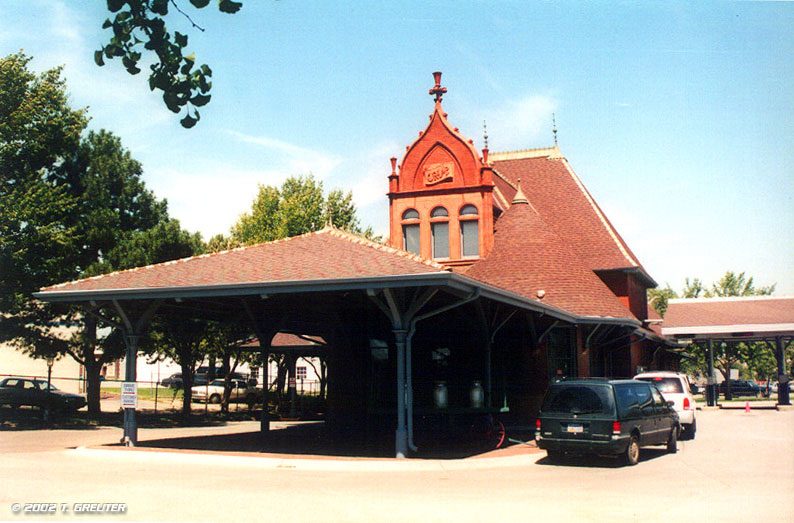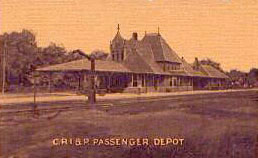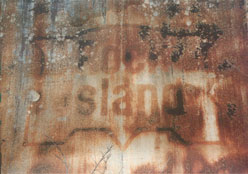 |
| In 1875, shortly after the track
was laid down, the CRI&P erected a depot, then east of town, near
Antelope Creek. This elaborate building still stands today. Purchased
by City National Bank & Trust (now Union Bank), the depot serves
as a drive through bank while retaining it's historical significance
to the city; August 2001 - T. Greuter photo |
 The Chicago, Rock Island & Pacific Railroad, the CRIP,
the Rock... whatever you may call it, the road is still one fondly
remember by many, even in the Burlington country of Lincoln, Nebraska.
Despite it's troubles, finally ending in bankruptcy in the early '80's,
the Rock is remembered for it's rich history.
The Chicago, Rock Island & Pacific Railroad, the CRIP,
the Rock... whatever you may call it, the road is still one fondly
remember by many, even in the Burlington country of Lincoln, Nebraska.
Despite it's troubles, finally ending in bankruptcy in the early '80's,
the Rock is remembered for it's rich history.
The
Rock's Beginning
The date
was October 1st, 1851 when the first spadeful of dirt was turned at Chicago
and railroad construction officially was begun on the new Chicago, Rock
Island & Pacific Railroad. One year later on October 10, a colorful
4-4-0 American-type locomotive named the Rocket, coupled to six
sparkling new yellow coaches belched a cloud of wood smoke and headed
west over the 58-pound iron rails that had been imported from England.
It wouldn't be until 1879 when plans were made to lay track into Nebraska,
Kansas, Colorado and Oklahoma.
The
Rock and Nebraska
On March
19, 1886, a charter was issued to the Chicago, Kansas and Nebraska Railway
Company to build the road in Kansas and Colorado, which included most
of the Nebraska mileage. One year to the day later, a contract was signed
between the Nebraska-based Union Pacific and the Chicago, Kansas and Nebraska
Railway Company for joint use of the U.P. tracks between Kansas City and
North Topeka for a period of 999 years.
 Two
years later, in 1890, the Rock Island was extending westward toward Jansen,
Nebraska, just east of Fairbury. From Jansen, construction moved on through
Limon, toward Colorado Springs. By June 10, 1891, through consolidations,
the lines in Nebraska, Kansas and Colorado all were brought into
the Rock Island System, a total of 1,476 miles of new railroad line. Construction
was also underway leading westward from Omaha on through Lincoln, for
a connection with the Colorado line at Jansen. Two
years later, in 1890, the Rock Island was extending westward toward Jansen,
Nebraska, just east of Fairbury. From Jansen, construction moved on through
Limon, toward Colorado Springs. By June 10, 1891, through consolidations,
the lines in Nebraska, Kansas and Colorado all were brought into
the Rock Island System, a total of 1,476 miles of new railroad line. Construction
was also underway leading westward from Omaha on through Lincoln, for
a connection with the Colorado line at Jansen.
The
Rock's Final Years
As the Rock
Island approached its centennial year of 1952, it was a strong railroad,
and one of the best in the country. The first diesel switchers had been
acquired in 1937, followed by the inauguration of Rock Island's first
streamliner, the Texas Rocket. Dieselized freights began in 1945,
with total dieselization acheived in 1952.
The Rock Island entered its third and final bankruptcy in 1975, and despite
the best efforts of management and trustee, and the flashy new blue and
white "Rock" image, the company could not survive,
and forced a bankruptcy.The Rock Island Railroad ceased to exist - ending
the liquidation of the railroad, the largest such liquidation in U.S.
history, and on March 23, 1980 the Cotton Belt Line took over. On March
31, 1980, the Chicago, Rock Island and Pacific Railroad operated its last
train.
 |
| The CRI&P erected a depot,
as it appeared in earlier days. This image is from a vintage postcard. |
The
Rock and Lincoln
In 1875,
the last of the city's five modern railroads arrived. The CRI&P extended
it's track from the Missouri River to Lincoln, and on south to Belleville
Kansas on it's KC-Denver mainline. An elaborate depot was built shortly
after along "O" Street and Antelope Creek (the creek's path
in town has been altered greatly since). As "O" Street grew
more heavily traveled with the age of automobile traffic and lined by
businesses, you can imagine the conflicts that could and did occur.
In Lincoln, you may
still find some lingering remnants of the road - the right-of-way is preserved
as a bike path in the rural far northeastern area of town and south through
the busy Antelope Creek/Folsom Children's Zoo neighborhood. Plans are
to finish the path on the NU campus where the Rock and MoPac intersected.
The elaborate passenger station in the downtown area is the proudest symbol
of the road to survive - it escaped the fate many other city depots met
by being preserved as a home to an area bank. In the neigborhoods near
the fairgrounds you may spot a forgotten boxcar overgrown by trees, the
Rock Island emblem barely visible.
|



















 The Chicago, Rock Island & Pacific Railroad, the CRIP,
the Rock... whatever you may call it, the road is still one fondly
remember by many, even in the Burlington country of Lincoln, Nebraska.
Despite it's troubles, finally ending in bankruptcy in the early '80's,
the Rock is remembered for it's rich history.
The Chicago, Rock Island & Pacific Railroad, the CRIP,
the Rock... whatever you may call it, the road is still one fondly
remember by many, even in the Burlington country of Lincoln, Nebraska.
Despite it's troubles, finally ending in bankruptcy in the early '80's,
the Rock is remembered for it's rich history.  Two
years later, in 1890, the Rock Island was extending westward toward Jansen,
Nebraska, just east of Fairbury. From Jansen, construction moved on through
Limon, toward Colorado Springs. By June 10, 1891, through consolidations,
the lines in Nebraska, Kansas and Colorado all were brought into
the Rock Island System, a total of 1,476 miles of new railroad line. Construction
was also underway leading westward from Omaha on through Lincoln, for
a connection with the Colorado line at Jansen.
Two
years later, in 1890, the Rock Island was extending westward toward Jansen,
Nebraska, just east of Fairbury. From Jansen, construction moved on through
Limon, toward Colorado Springs. By June 10, 1891, through consolidations,
the lines in Nebraska, Kansas and Colorado all were brought into
the Rock Island System, a total of 1,476 miles of new railroad line. Construction
was also underway leading westward from Omaha on through Lincoln, for
a connection with the Colorado line at Jansen. 




